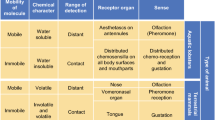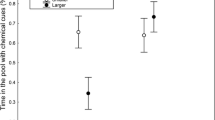Abstract
Individual crayfish (Orconectes virilis) were tested for responses to water containing conspecific individuals of several sex-status categories. Isolated males did not react to “self” water but did show aggressive postures while isolated, nonself male water was introduced. Males' responses to female water was different from responses to male water. Water from aggressing males elicited fewer agonistic postures and more “neutral” postures. Females showed little difference in response to waters from different categories of conspecifics.
Similar content being viewed by others
References
Atema, J., andStenzler, D. 1977. Alarm substance of the marine mud snail,Nassarius obsoletus: Biological characterization and possible evolution.J. Chem. Ecol. 3:173–187.
Ameyaw-Akumfi, C.E. 1976. Some aspects of breeding biology of crayfish. PhD dissertation. University of Michigan, Ann Arbor, 252 pp.
Ameyaw-Akumfi, C. 1979. Appeasement displays in cambarid crayfish (Decapoda, Astacoidea).Crustaceana, Suppl. 5:135–141.
Ameyaw-Akumfi, C., andHazlett, B.A. 1975. Sex recognition in the crayfishProcambarus clarkii.Science 190:1225–1226.
Caldwell, R.L. 1979. Cavity occupation and defensive behaviour in the stomatopodGonodactylus festae: Evidence for chemically mediated individual recognition.Anim. Behav. 27:194–201.
Caldwell, R.L. 1984. A test of individual recognition in the stomatopodGonodactylus festae. Anim. Behav. In press.
Cane, V. 1963. Some ways of describing behaviour, pp. 361–388,in W.H. Thorpe and O.L. Zangwill (eds.). Current Problems in Animal Behaviour. Cambridge University Press, London.
Hazlett, B.A. 1966. Social behavior of the Paguridae and Diogenidae of Curacao.Stud. Fauna Curacao 23:1–143.
Hazlett, B.A. 1983. Parental behavior in decapod Crustacea, pp. 171–193,in Studies in Adaptations, The Behavior of Higher Crustacea. S. Rebach and D. Dunhams (eds.). Wiley & Sons, New York.
Hazlett, B.A. 1984. Experimental design and ecological realism.J. Chem. Ecol. 10:1281–1282.
Hazlett, B.A., Rittschof, D., andRubenstein, D. 1974. Behavioral biology of the crayfishOrconectes virilis I. Home range.Am. Midi. Nat. 92:301–319.
Itagaki, H., andThorp, J.H. 1981. Laboratory experiments to determine if crayfish can communicate chemically in a flow-through system.J. Chem. Ecol. 7:115–126.
Landauer, M.R., andChapnick, S.D. 1981. Responses of terrestrial slugs to secretions of stressed conspecifics.Psychol. Rep. 49:617–618.
Little, E.E. 1975. Chemical communication in maternal behavior of crayfish.Nature 255:400–401.
Little, E.E. 1976. Ontogeny of maternal behavior and brood pheromone in crayfish.J. Comp. Physiol. 112:133–142.
Rose, R.D. 1982. On the nature of chemical communication by crayfish in a laboratory controlled flow-through system.J. Chem. Ecol. 8:1065–1071.
Rubenstein, D.I., andHazlett, B.A. 1974. Examination of the agonistic behavior of the crayfishOrconectes virilis by character analysis.Behaviour 50:193–216.
Stenzler, D., andAtema, J. 1977. Alarm response of the marine mud snail,Nassarius obsoletus: Specificity and behavioral priority.J. Chem. Ecol. 3:159–171.
Teytaud, A.R. 1971. The laboratory study of sex recognition in the blue crabCallinectes sapidus Rathbun.Sea Grant Tech. Bull. 15:1–63.
Tierney, A.J., andDunham, D.W. 1982. Chemical communication in the reproductive isolation of the crayfishesOrconectes propinquus andOrconectes virilis (Decapoda, Cambaridae).J. Crust. Biol. 2:544–548.
Thorp, J.H. 1984. Theory and practice in crayfish communication studies.J. Chem. Ecol. 10:1283–1287.
Thorp, J.H., andAmmerman, K.S. 1978. Chemical communication and agonism in the crayfishProcambarus acutus acutus.Am. Midl. Nat. 100:471–474.
Thorp, J.H., andItagaki, H. 1982. Verification versus falsification of existing theory: Analysis of possible chemical communication in crayfish.J. Chem. Ecol. 8:1073–1077.
Vonfrisch, K. 1938. Zur psychologie des Fisch-Schwarmes.Naturwissenschaften 26:601–606.
Author information
Authors and Affiliations
Rights and permissions
About this article
Cite this article
Hazlett, B.A. Chemical detection of sex and condition in the crayfishOrconectes virilis . J Chem Ecol 11, 181–189 (1985). https://doi.org/10.1007/BF00988201
Received:
Accepted:
Issue Date:
DOI: https://doi.org/10.1007/BF00988201




